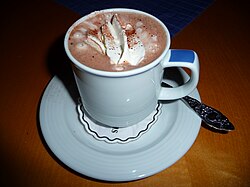Hot cocoa

|
|
| Type | Hot Cocoa |
|---|---|
| Country of origin | Central America |
| Color | Brown or chestnut |
| Flavor | Chocolate |
| Ingredients | Chocolate or cocoa powder, milk or water, sugar |
| Nutritional value per 100 g | |
|---|---|
| Energy | 322.168 kJ (77.000 kcal) |
|
10.74 g
|
|
| Sugars | 9.66 g |
| Dietary fiber | 1 g |
|
2.34 g
|
|
| Saturated | 1.431 g |
| Trans | 0.078 g |
| Monounsaturated | 0.677 g |
| Polyunsaturated | 0.084 g |
|
3.52 g
|
|
| Vitamins | |
| Vitamin A equiv. |
(6%)
51 μg |
| Vitamin A | 176 IU |
| Thiamine (B1) |
(3%)
0.039 mg |
| Riboflavin (B2) |
(15%)
0.182 mg |
| Niacin (B3) |
(1%)
0.133 mg |
| Vitamin B6 |
(3%)
0.04 mg |
| Folate (B9) |
(1%)
5 μg |
| Vitamin B12 |
(20%)
0.49 μg |
| Vitamin C |
(0%)
0.2 mg |
| Vitamin D |
(7%)
1.1 μg |
| Vitamin D |
(8%)
45 IU |
| Vitamin E |
(0%)
0.03 mg |
| Vitamin K |
(0%)
0.2 μg |
| Minerals | |
| Calcium |
(11%)
114 mg |
| Iron |
(3%)
0.42 mg |
| Magnesium |
(6%)
23 mg |
| Phosphorus |
(15%)
105 mg |
| Potassium |
(4%)
197 mg |
| Sodium |
(3%)
44 mg |
| Zinc |
(7%)
0.63 mg |
| Other constituents | |
| Water | 82.45 g |
| Caffeine | 2 mg |
| Cholesterol | 8 mg |
|
|
| Percentages are roughly approximated using US recommendations for adults. Source: https://ndb.nal.usda.gov/ndb/search/list?qlookup=01105 |
|
Hot chocolate, also known as hot cocoa, drinking chocolate or just cocoa is a heated beverage consisting of shaved chocolate, melted chocolate or cocoa powder, heated milk or water, and often sugar. Hot chocolate may be topped with whipped cream. Hot chocolate made with melted chocolate is sometimes called drinking chocolate, characterized by less sweetness and a thicker consistency.
The first chocolate beverage is believed to have been created by the Maya around 2,000 years ago, and a cocoa beverage was an essential part of Aztec culture by 1400 AD. The beverage became popular in Europe after being introduced from Mexico in the New World and has undergone multiple changes since then. Until the 19th century, hot chocolate was even used medicinally to treat ailments such as liver and stomach diseases.
In the 2010s, hot chocolate is consumed throughout the world and comes in multiple variations, including the spiced chocolate para mesa of Latin America, the very thick cioccolata calda served in Italy and chocolate a la taza served in Spain, and the thinner hot cocoa consumed in the United States. Prepared hot chocolate can be purchased from a range of establishments, including cafeterias, fast food restaurants, coffeehouses and cafes. Powdered hot chocolate mixes, which can be added to boiling water or hot milk to make the drink at home, are sold at grocery stores.
An early Classic period (460-480 AD) Mayan tomb from the site of Rio Azul, Guatemala, had vessels with the Maya glyph for cacao on them with residue of a chocolate drink. To make the chocolate drink, which was served cold, the Maya ground cocoa seeds into a paste and mixed it with water, cornmeal, chili peppers, and other ingredients. They then poured the drink back and forth from a cup to a pot until a thick foam developed. Chocolate was available to Maya of all social classes, although the wealthy drank chocolate from elaborately decorated vessels.
...
Wikipedia
